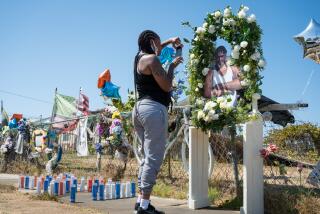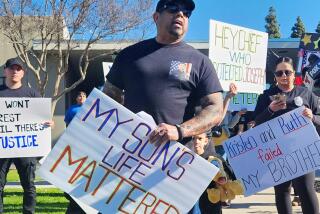Months before George Floyd’s death, Angel Zapata Hernandez died in San Diego with a knee to his neck
SAN DIEGO — For weeks during the pandemic spring and summer of 2020, thousands of San Diego residents took to the streets around the county, protesting racial injustice and police misconduct in the wake of the May 25 killing of George Floyd at the hands of Minneapolis police.
Floyd’s excruciating death — with then-Officer Derek Chauvin’s knee on Floyd’s neck — was captured on a now-famous cellphone video that, once shared on social media, set off weeks of protests around the world.
What the demonstrators in San Diego did not know in those weeks was that a similar death had occurred months before, on the evening of Oct. 15, 2019, in the city’s downtown: 24-year-old Angel Zapata Hernandez died while handcuffed and restrained at the hands of two Metropolitan Transit Service security workers, one of whom knelt on his neck for six minutes and seven seconds.
At the very time the protesters were filling the streets demanding change, police and prosecutors were reviewing Zapata Hernandez’s death, which like Floyd’s was also captured on videotape in agonizing detail.
Aside from a vaguely worded news release from the San Diego Police Department one day after Zapata Hernandez died, few people outside of law enforcement knew the circumstances of his death. It was not until Monday — when Metropolitan Transit Service board Chairman Nathan Fletcher and Zapata Hernandez family lawyer Eugene Iredale announced at a news conference that the transit system was settling a claim from family members for $5.5 million — that the video, which contains scenes that some viewers may find disturbing, was released publicly.
The reasons why Angel Zapata Hernandez’s death was all but hidden from public knowledge for nearly 18 months are many. The unique status of MTS security — they are not sworn police officers or peace officers under the law — put them out of reach of some police transparency legislation that could have led to release of the video and information about the death earlier.
A state law that took effect three months before Zapata Hernandez’s death mandates the release of body-camera video within 45 days in instances when police shoot someone or use force that results in death or “great bodily injury,” with some exceptions. But the law applies to police and custodial officers — not MTS officers or its security officers.
Without video recorded by witnesses or video released by police, the only information about Zapata Hernandez’s death at the time came from a San Diego Police Department statement that omitted crucial details, including the fact that the officers kept their knees and hands on Zapata Hernandez for several minutes.
“Initial information provided by witnesses and the MTS employees indicate the male was acting erratically and was possibly under the influence,” the Oct. 16, 2019, statement read. “The witnesses did not see any use of force by the MTS employees other than trying to hold the male down on the ground as he kicked and screamed.”
Toxicology reports later showed trace amounts of marijuana but no illegal drugs in his system. His family said he was diagnosed with schizophrenia and took medication for it daily.
Police kept information from the public in another way: The autopsy was sealed at the request of San Diego police. In a letter dated Oct. 24, 2019, a police sergeant requested the seal, saying the release of information about the case would “seriously hamper” the investigation.
The letter states homicide suspects communicate “with their peers” and that considering the notion that “certain facts are known only to the suspect and detectives involved,” detectives could “narrow the scope of their investigation” if details were kept from the public.
In addition, Zapata Hernandez’s family did not want the video made public while the legal claim against the agency went through a mediation process, which eventually led to the settlement, Fletcher said.
Fletcher said he knew the video would eventually become public, and also wanted to abide by the family’s wishes. “It was their specific request, ‘We don’t want it released pending mediation,’” Fletcher said.
Iredale confirmed that the family did not want the video widely distributed. Zapata Hernandez’s mother, Claudia, still has not seen it, he said.
Another reason is that no one was prosecuted in the death of Zapata Hernandez. San Diego County Dist. Atty. Summer Stephan decided in July that there was not enough evidence to prove charges of either murder or manslaughter. She quietly informed MTS but the office made no other announcement.
Stephan declined a request for an interview with her or any of the three prosecutors who also reviewed the case. Spokeswoman Tanya Sierra cited a policy that the office does not discuss charging decisions. However, because of the guilty verdict last week in the Chauvin case and the revelations of the Zapata Hernandez case, Sierra provided a lengthy statement giving more details behind the decision.
“This type of case relies heavily on the Medical Examiner’s findings,” the statement read in part, “and the two opinions provided by medical examiners did not support that being held down by one of the MTS employee’s knee substantially contributed to Mr. Zapata Hernandez’ death.”
It also said the two security guards — one an MTS employee, the other an employee of Allied Universal, which contracts to augment security for MTS — could not be held legally liable.
Both no longer work for MTS, and are not being identified because the San Diego Union-Tribune has not yet been able to locate either of them for comment.
According to the DA statement: “Our review found that no specific act taken by any individual, or in combination, can be shown to have caused the death of Mr. Zapata-Hernandez. Nor did the death of Zapata-Hernandez result as the natural and probable consequence of any individual act.”
The two did not intend to kill Zapata Hernandez, the DA statement read. In fact they detained Zapata Hernandez, who was first spotted wandering on the train tracks, ran away from the officers, and can be heard on the videos yelling incoherently, because they were concerned he was under the influence of drugs and would hurt himself.
Two deaths, two different outcomes
The deaths of Zapata Hernandez and Floyd were separated by time and hundreds of miles. But there are similarities between both.
Chauvin knelt on Floyd’s neck for nine minutes and 29 seconds. The MTS guards were on top of Zapata Hernandez’s back, shoulders, and neck for as long as nine minutes and 41 seconds, according to a report from a police practices expert hired by Iredale.
Both men died face down, handcuffed, with a knee pressed directly on their neck. The cause of death was nearly identical: The San Diego County Medical Examiner concluded Zapata Hernandez died of “sudden cardiopulmonary arrest while in a prone restraint” and said heart disease was a contributing factor.
The medical examiner in Hennepin County in Minnesota ruled Floyd died of “cardiopulmonary arrest complicating law enforcement subdual, restraint, and neck compression,” and cited heart disease and drug use as contributing factors. Each death was ruled a homicide — a death at the hands of another person.
“Same mechanism, diagnosis and autopsy finding,” Iredale said.
The chain of events that led to their fatal encounters with authorities began from minor, even benign circumstances: Floyd was suspected of passing a counterfeit $20 bill in a neighborhood corner grocer. The MTS officer who first encountered Zapata Hernandez wandering on the train tracks near the Santa Fe Depot downtown had been sent to the area to check out a report of an unattended backpack. It was never found.
There is also a connection in the aftermath of both deaths. Dr. William Smock, a forensic medicine expert with the Louisville Metro Police Department in Kentucky, testified as an expert witness for the prosecution in the Chauvin case and said Floyd died from positional asphyxia. “He died because he had no oxygen in his body,” Smock testified.
Smock also was hired by Iredale. In a report in the Zapata Hernandez case, Smock flatly disagrees with the San Diego County Medical Examiner’s Office. “Mr. Angel Zapata-Hernandez was handcuffed in the prone position and was in the custody of the Metropolitan Transit Service (MTS) when he was rendered unconscious and died as a direct consequence of the application of external pressure applied to his back, neck and abdomen,” Smock wrote.
In the statement, however, the San Diego County District Attorney’s Office said there were key differences between the two deaths. During the months-long review prosecutors interviewed the two pathologists who conducted the autopsy, Dr. Timothy Jong and Dr. Robert Stabley, on their findings.
Jong and Stabley both said several factors contributed to the death, including the struggle with the MTS employees, being in a prone position with pressure to the neck and torso, and “a host of health factors,” the statement read. Jong, when asked if Zapata Hernandez would have died without a knee on his neck, said: “I favor that he probably would have.”
Since the release of the video, several criminal justice reform advocates have criticized the decision. Activist Tasha Williamson said she felt a sense of frustration when she saw the never-before-released video of Zapata Hernandez’s death.
“I wept like it was George Floyd,” she said. “Y’all kept it from us?”
She said Zapata Hernandez’s death was not a case of self-defense and questioned why the district attorney’s office decided not to file criminal charges stemming from negligence.
“Negligence has consequences in the streets, but it never seems to have consequences for officers or security officers who kill us? There’s no accountability,” she said.
Settlement and reform
Fletcher said Stephan notified him July 17 that no charges would be brought. That same day, after the video was released from the DA review, he saw it for the first time, he said. An hour later, he was on the phone with Iredale.
“My world fundamentally changed on July 17 when I saw that video,” he said. “It’s chilling to watch.”
He told Iredale that MTS wanted to settle the case, apologize to the family and make changes. Within three days both sides were exchanging information, like investigation reports and personnel materials, and the Hernandez family was interviewed by MTS lawyers.
Both sides agreed to a mediation in front of retired U.S. District Judge Irma Gonzalez. After two sessions, the latest in February, a settlement was reached. The mediations took longer because of complications caused by the COVID-19 pandemic, Fletcher said.
Iredale, a veteran civil rights lawyer with a long record of successfully suing agencies over civil rights violations, said at first he was skeptical of Fletcher’s motivation but soon saw it was legitimate. He said no leader of an agency he was preparing to sue had ever before contacted him with an offer to resolve the case.
“It really surprised me,” Iredale said. “I was eventually impressed by their good faith.”
Meanwhile Fletcher was moving to finalize and expand the changes to MTS security already in the works. “Reforms were underway but they needed to be more substantive,” he said. On July 30 he held a closed session with the board where the disturbing video was viewed.
Zapata Hernandez’s death prompted sweeping changes to MTS enforcement policies and training.
Among the changes was to its use-of-force policy, rolled out in July and updated in September, that among other measures banned carotid restraints, choke holds and knee pressure on a neck, throat or head. Fletcher said the agency also is committed to banning holding people in the prone position.
More training was added, and the agency intends to improve the hiring process for officers.
Andrea Guerrero, executive director of Alliance San Diego, a social justice organization that worked with MTS on the policy changes, said Zapata Hernandez’s death was similar to other stories of “unnecessary” deaths.
“But this case is also different,” Guerrero said during Monday’s news conference. “In this instance, MTS has done what is so rare: It has acknowledged its wrongdoing, it has apologized to the family and is committing to policy reforms so that this does not happen again.”
More to Read
Sign up for Essential California
The most important California stories and recommendations in your inbox every morning.
You may occasionally receive promotional content from the Los Angeles Times.












